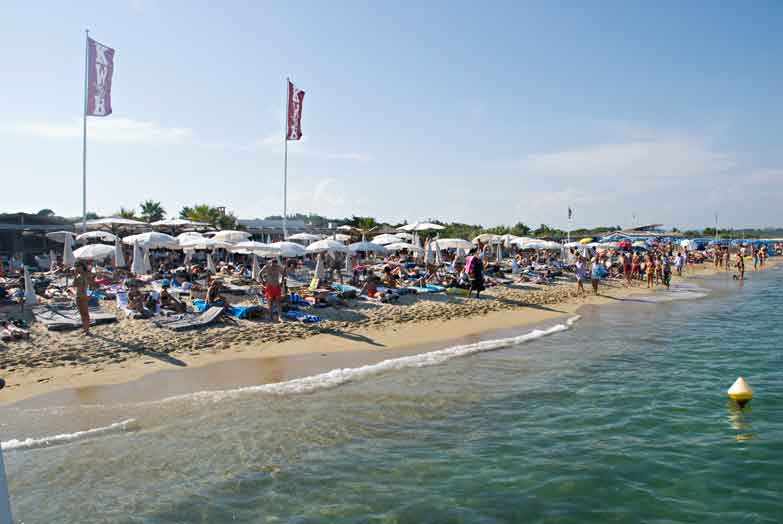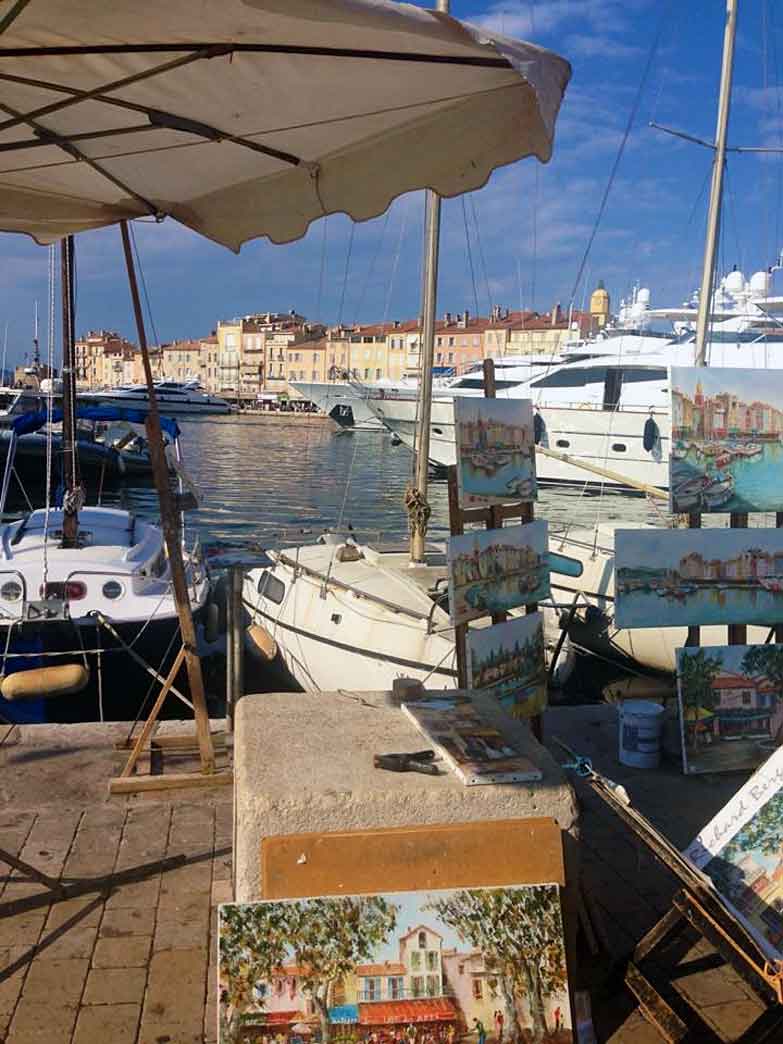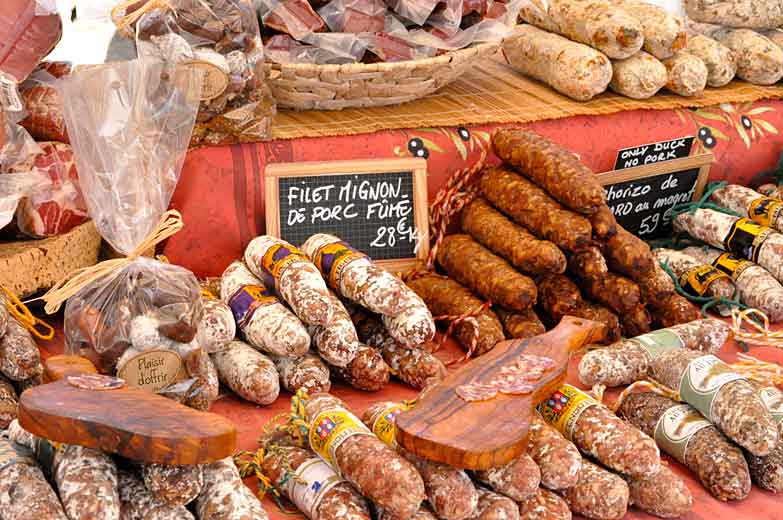
In truth, the images are not far off. There are yachts. And stars. And lots and lots of beaches with tanned bodies sprawled about them dressed in little more than a squirt of SPF 4.
Yet despite its well-earned hedonistic reputation, St-Tropez possesses a certain mystique that has lingered here since long before a pouty young ingénue named Brigitte Bardot came along in the mid-1950s and splashed the whole town with limelight. Scrape away the gilded patina of new money (and avoid the nearly 100,000 visitors who rumble in each summer) and the once-humble fishing port, military stronghold and artist enclave still shimmers beneath the plane trees on the Place des Lices, in the cannonball-marred walls of the fortified Citadel, and along the narrow cobbled streets that have bewitched visitors for centuries.
![[st-tropez1_cs] The distinctive bell-tower of Notre Dame de l'Assomption dominates the skyline. Image by Nicolas Thibaut / photononstop / Getty Images. [st-tropez1_cs] The distinctive bell-tower of Notre Dame de l'Assomption dominates the skyline. Image by Nicolas Thibaut / photononstop / Getty Images.](https://www.holidaytravel.cc/Article/UploadFiles/201602/2016021918354538.jpg)
The famous and infamous have tanned their body parts along the sandy stretch of Pampelonne beach, where umbrella-covered clubs line up like obedient clones. Go for thumping DJ-spun music and 20-euro glasses of rosé wine if you must, then take a hike. Literally.
The Sentier du Littoral (coastal path) follows the perimeter of the St-Tropez peninsula, from the ramparts at the far end of the port to the top of Pampelonne beach (or do it backwards). The footpath meanders past the town’s cemetery (killer views, no pun intended), hidden villas, and several tempting crystalline swimming holes. Quieter beaches like the Plage des Canebiers, Plage de la Moutte, and Plage des Salins will also fall in your footsteps. Once at Pampelonne, take the Rue de Tahiti two miles back to town.

St-Tropez occupied a strategic military position long before it was a jet-setter’s oasis. Built between 1590-1607 to defend the coastline against invaders, the Citadel still keeps watch over villagers and the sea, though only a few roaming peacocks and some defunct cannons stand guard these days. Predating the Citadel are three medieval towers guarding the port - Portalet, Jarlier and Suffren, the oldest building in St-Tropez.
If you arrive in mid-May and hear gunfire, don’t head for the hills. Les Bravades dates to the 15th century and is a traditional (and loud) Provencal religious and military celebration held over three days each May that gives grown men a good excuse to don old military uniforms and fire muskets. Backed by a drum corps, parades and jubilant onlookers, this celebration is a beloved St-Tropez event, honoring military history as well as the town’s patron saint, Saint Torpes, whose bust is marched through the narrow lanes.
Hire a taxi or scooter and head to the simple Provençal-style Chapelle Ste-Anne located atop a hill in a residential area above the Place des Lices. Built in 1618, the chapel made pop culture history in 1971 when Mick Jagger married Bianca here after a civil ceremony at the St-Tropez town hall. The iconic and oft-photographed bell tower of St-Tropez belongs to the Italian baroque-style Notre Dame de l'Assomption, which contains a wooden bust of Saint Torpes.

The elixir of choice on the French Riviera is wine - rosé to be exact. The bucolic St-Tropez peninsula is smothered with grapevines, part of the Côte de Provence wine region where family-run estates are producing some of the country’s best. Among them, Chateau Minuty (www.chateauminuty.com), Chateau des Marres (www.chateaudesmarres.com) and Chateau de Chausse (chateaudechausse.fr), are found on Michelin-starred menus in Paris.
Daily life in Provence starts at the market, and St-Tropez’s largest unfolds on the main square, Place des Lices, on Tuesdays and Saturdays. The daily fish market is a highlight, with fresh catch hauled in each morning by local fishermen to the nearby Porte de la Poissonnerie, as it has been for centuries. The town’s namesake cake, La Tarte Tropezienne (check it out here), is a must and rarely found beyond surrounding villages. Two sugar-crusted brioche, sandwiching a creamy custard layer, the St-Tropez specialty supposedly got its name from Brigitte Bardot, who suggested it to baker Alexandre Micka while filming And God Created Woman on the nearby beaches.

St-Tropez was fertile ground for artists at the turn of the 20th century, thanks to Paul Signac. He fell in love with the colour and light in St-Tropez, settled into a studio here, and invited other painter pals to visit - among them Henri Matisse, Pierre Bonnard, and Henri-Edmond Cross. An impressive trove hangs at the charming Musée de l'Annonciade, a former chapel on the swanky waterfront, and highlights the Pointillist, Fauvist and Nabis painting styles that emerged here. Treat your feet to the ultimate St-Tropez souvenir, a pair of Rondini Sandals (admire them here), called Tropeziennes, naturally. Since 1927 the family, and a dozen or so artisans, have cobbled their popular leather footwear in the back of the tiny storefront that is often jammed. The gladiator style is most famous, and the sandals can’t be purchased anywhere else.